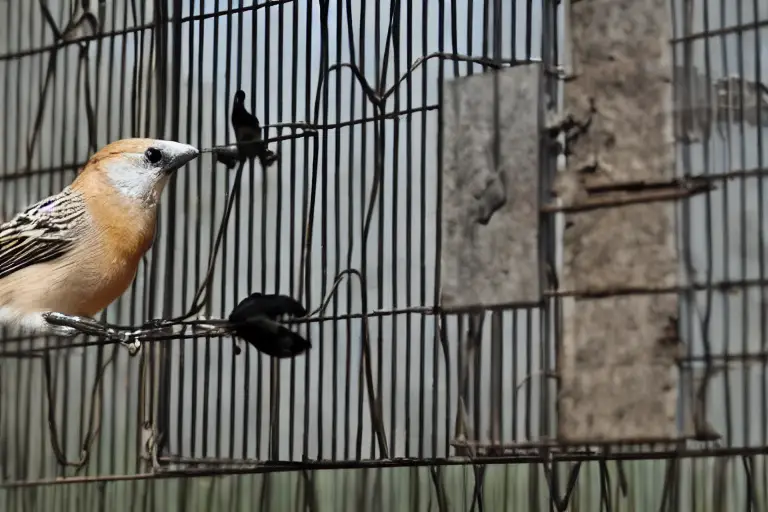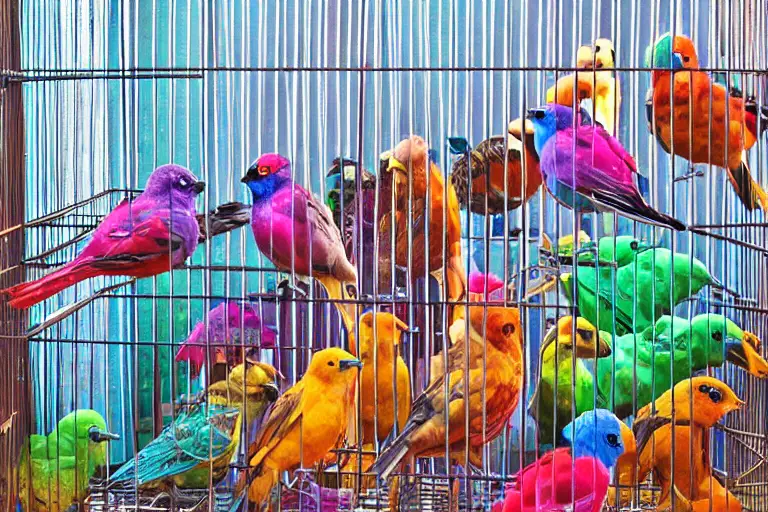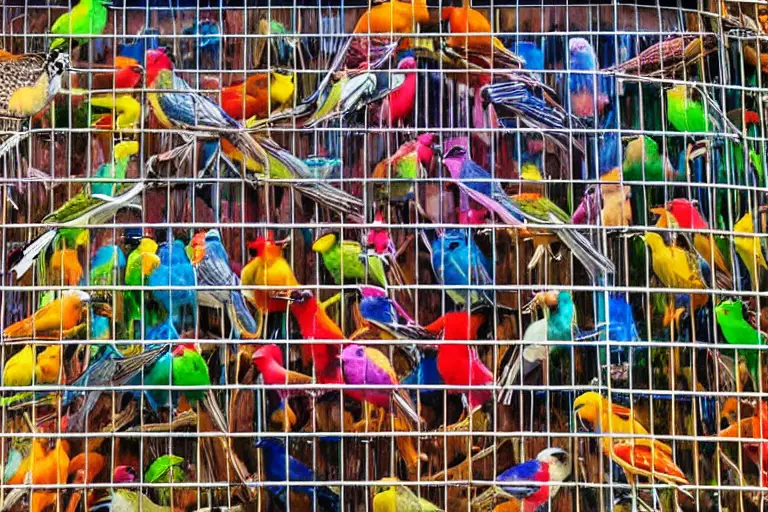The age-old question of whether birds like being in cages has been pondered for centuries since the days of Aristotle. But does living in enclosures truly benefit our feathered friends? In this article, we will explore what modern research can tell us about a bird’s experience within a cage and how to provide an enriched life for those who live there.
Some might argue that birds do not like being in cages because they are confined and unable to roam freely. Others might say that birds enjoy the safety and security of being in a cage and feel comfortable and safe there. Ultimately, it is up to the individual bird to decide whether or not it enjoys being in a cage.
We all know that animals need freedom and exercise just as much (if not more) as humans do. However, some pet birds spend their entire lives inside small cages without access to any natural environment or stimuli. It is no surprise, then, that many become restless and even neurotic over time – leading to bad behavior such as feather plucking and aggression towards other birds and people alike.
But it doesn’t have to be this way! There are plenty of ways owners can ensure their feathered companions get adequate space, activity, mental stimulation, and social interaction, so they don’t feel confined or bored in their cages. By understanding the needs of these wonderful creatures, we can give them the best chance at thriving regardless of where they spend most of their day.
How Being In A Cage Affects Different Species Of Birds
The idea of birds living in cages is like a prison for the soul. It’s an imprisonment that takes away their freedom to soar and see the world from above, as nature intended. Even though some species may find solace within its walls, for others, it can be devastating to both physical and mental health.
In this article, we’ll explore how being in a cage affects different species of birds. By looking at the pros and cons of keeping birds in captivity, we can gain insight into whether they are suitable candidates for such a lifestyle or not.
For many smaller bird species, such as parakeets and finches, life in a cage isn’t always detrimental if certain conditions are met. Providing them with adequate space to fly freely inside their enclosure helps keep them healthy and active, which would otherwise be impossible due to predators outside their habitat. Additionally, having access to food sources and water on tap means these small creatures will never go hungry or thirsty again! On the other hand, larger bird species require more room than most cages offer; this could lead to frustration-induced behaviors such as pecking at bars or plucking out feathers.
Therefore, when deciding whether or not it’s beneficial for any given species of bird to live in captivity, one must consider both the needs of the individual animal and its natural environment preferences. It’s important to note that what works for one type of avian creature won’t necessarily work for another – thus making it essential to research thoroughly before committing to providing accommodation through caging methods. Moving forward, then let’s consider the pros and cons of keeping birds in cages.

The Pros And Cons Of Keeping Birds In Cages
Keeping birds in cages can be a double-edged sword. On the one hand, when done responsibly, it’s an excellent way to bond with your feathered friends and keep them safe from potential predators. On the other hand, if not carefully considered, it could also lead to serious consequences for their well-being. To help you make the best decision for your bird’s welfare, here are some of the pros and cons of keeping birds in cages:
Pros:
- Allows for close interaction between bird and owner
- Keeps them safe from external threats such as cats or other animals
- Encourages mental stimulation through toys and activities
- It helps regulate routine feeding times better
Cons:
- May cause depression due to a lack of freedom
- Can limit physical exercise opportunities by confining movement within cage limits
- Possibility of developing feather plucking problems due to boredom or stress-related issues
- Risk of becoming over-dependent on humans rather than learning how to fend for themselves in nature
Before making any decisions about putting your feathered friend into a cage, it’s important that you weigh up all these points carefully – like walking a tightrope! It goes without saying that selecting the right size cage is equally critical; larger ones will give more room to fly around, while smaller cages should only ever be used temporarily. Doing so will ensure your bird has enough space to move freely while being protected at home.
Selecting The Right Cage For Your Bird
Did you know that parrots can live up to 80 years in captivity? That’s why selecting the right cage for your bird is so important. After all, providing a comfortable and safe environment will allow your pet to thrive and enjoy its life.
There are many considerations to keep in mind when selecting the ideal home for your feathered friend:
- Size: The cage should be large enough for your bird to move around comfortably;
- Material – Choose one made from durable material such as stainless steel or wrought iron;
- Safety: Make sure there are no sharp edges or protrusions where your pet might get injured;
- Accessories: Select accessories like perches, swings, ladders, and toys.
It’s also recommended that you choose cages with multiple levels to provide a variety of activities for your bird. This will help them stay healthy and entertained while keeping their minds stimulated.
Having a bustling environment inside the cage is just as important as having the right size and materials. Provide plenty of interaction opportunities by placing suitable toys, mirrors, bells, and other exciting items throughout the enclosure. Additionally, ensure they have access to food, water, and fresh air circulation. With these tips in mind, you can ensure that your feathery pal has an enjoyable living space!

How To Create A Stimulating Cage Environment
As if stepping into a time machine, the concept of creating an environment for your bird that’s stimulating is timeless. A great home should provide the necessary resources to ensure it has everything it needs to thrive, and in this case, we’re talking about our feathered friends!
When designing a cage setup, focus on providing plenty of perching opportunities at different levels and space for toys and other activities. This will help encourage natural behaviors while keeping them safe from predators or hazards. Additionally, ensure there are spots where they can hide away when feeling stressed or overwhelmed. Many birds also appreciate having access to mirrors, so don’t forget these important additions!
It is also essential to consider what kind of diet you’ll feed your pet. It should meet their nutritional needs and reflect fresh foods whenever possible; seeds alone won’t do the trick here. By utilizing healthy options such as fruits and vegetables alongside fortified seed mixes, you’ll be helping ensure your companion stays happy and content with its new digs.
So while some might feel uneasy leaving their beloved bird locked up in a cage all day long – remember that with the right care, attention, and environment, it doesn’t have to remain caged forever! With careful consideration and planning ahead of time, transitioning a bird from its living quarters back into the wild becomes much more achievable than one could imagine.
How To Transition A Bird From Cage To The Wild
Transitioning a bird from its cage to the wild can be an exciting yet daunting task. If you’re considering allowing your bird to return back into nature, there are some important steps that I recommend taking.
First and foremost, ensuring your bird is healthy enough for this transition is essential. You’ll want to consult with a vet to ensure they have no physical ailments or injuries that could prevent them from being able to take care of themselves out in the wild. Additionally, it’s beneficial to know roughly where the bird came from so that you know what kind of climate and environment they should adjust better to once released.
In order to give your feathered friend their best chance at success post-release, here are five things to consider:
- Acclimate your pet to outdoor elements by slowly introducing them outside over time;
- Get advice from experts on how much space birds need when transitioning;
- Start feeding your birds foods native to their original location;
- Provide a safe place for them nearby until they become accustomed to their new surroundings; and finally,
- Offer treats along with positive reinforcement as rewards for desired behaviors.
With these tips and precautions carefully taken, you and your beloved pet will hopefully find joy in having one last special moment together before they soar away!

Frequently Asked Questions
What Is The Lifespan Of A Bird In Captivity Versus One In The Wild?
The idea of a bird being caged can be unsettling. It’s as if their freedom is taken away, leaving them feeling helpless and trapped. But what about the lifespan of these feathered friends? How does captivity compare to life in the wild? Let’s find out!
Captivity may provide birds with an easier lifestyle than they’d have in nature; however, it could potentially lead to shorter lifespans for some species. In captivity, birds have access to better nutrition, medical care, and protection from predators, all beneficial for longevity. They also often lack the physical challenges of everyday life in the wild, like finding food or avoiding danger. On the other hand, living freely has its own advantages; studies show that wild birds tend to live longer on average due to various environmental benefits:
- Wild birds experience natural selection, enabling them to adapt to environmental changes, such as climate or seasonal variations.
- The pressure of competition among other species encourages them to remain fit and healthy to survive in hostile conditions.
In addition, researchers suggest that captivity reduces stress levels since there aren’t many threats around – this means less energy spent on worrying about survival and more energy directed towards activities such as socializing or mating. Ultimately, whether a bird lives longer in captivity depends largely upon its species-specific needs and preferences and how much care it receives from its keeper.
So while both environments offer unique opportunities for our avian friends, understanding the pros and cons of each option will help us make informed decisions about where we should house our beloved feathered companions!
How Often Should I Let My Bird Out Of The Cage?
Watching my pet bird take flight for the first time is a tremendous feeling. I was filled with joy and amazement as it soared around my living room! That said, how often should I let my avian friend out of its cage?
This can vary from species to species, but generally speaking, allowing your feathered companion some freedom outside regularly is essential if you want them to remain healthy and happy. Depending on their size and temperament, birds may need anywhere between 30 minutes to several hours of supervised outdoor playtime per day. This also allows them to stretch their wings and get some exercise – something they were born to do!
So when it comes down to it, there are no hard-and-fast rules about how often you should let your pet bird out of its cage; each situation is unique. However, by providing ample opportunities for fresh air, sunshine, and freedom in a safe environment, such as a screened porch or outdoor aviary – you can ensure that your beloved bird enjoys the best quality of life possible.
What Are The Best Toys To Put In A Bird’s Cage?
Coincidentally, I just bought a birdcage for my pet parrot. So, I wondered what the best toys to put in them were. As an animal lover, having gone through this journey myself, here are some ideas that might help you too!
First, the most important thing is giving your bird enough space and freedom within its cage. This means ensuring enough room to fly around and move freely. If not, even the best toy won’t make up for cramped living quarters.
Now let’s get into the fun stuff: Toys! Here’s a 3-item list of things birds love playing with:
- Ropes or ladders
- Puzzles
- Mirrors or bells.
Ropes or ladders provide exercise while also giving them something to climb on, which is great if they have limited flying time outside their cage.
Puzzles stimulate their mind by encouraging problem-solving skills.
And finally, mirrors and bells will keep them entertained as they figure out how these objects work and respond to different situations.
Ultimately, what matters most is providing enrichment materials that cater specifically to your pet’s needs so that it can stay physically and mentally active within its home environment!
Are There Any Health Benefits To Keeping Birds In Cages?
Keeping birds in cages can provide health benefits to the birds, but it’s important to do so responsibly. An owner should be careful when considering how much space their feathered friends need and what toys they will enjoy. Here are three things to consider when deciding if keeping a bird in a cage is right for you:
- The size of the cage matters. A too-small cage may not give your pet enough room to move around and flap its wings comfortably, potentially resulting in physical or mental distress. On the other hand, an overly large cage could make the bird feel overwhelmed and insecure. Finding the right balance between these two extremes is key to providing your pet with a safe and comfortable home.
- Toys that encourage natural behaviors should be provided for enrichment purposes. Various wood blocks, rope swings, mirrors, ropes, bells, and ladders can help keep your pet entertained while also helping them stay active mentally and physically. These items allow birds to exercise their nesting instincts and explore new scents and textures, all essential for promoting good psychological well-being.
- Lastly, it’s important to remember that even with plenty of space and enriching toys inside their cages, birds still need regular interaction with people outside the cage to remain physically and emotionally healthy. Taking your bird out regularly for quality one-on-one time is essential for building trust between you two and giving them opportunities to explore more stimulating environments than in their homes.
So whether you’re looking at getting a pet parrot or want to spruce up your existing avian friend’s living quarters, taking into account these three aspects – proper sizing, enrichment activities such as toys, and socialization through human contact – will ensure that everyone involved enjoys many happy years together!
Is It Possible To Train A Bird To Stay In A Cage?
Have you ever wondered if it’s possible to train a bird to stay in a cage? It might sound like an impossible feat, but with the right knowledge and patience, it can actually be done! From my experience of owning birds for many years, here are four things that I have learned about training them successfully:
First, start by introducing your pet bird slowly to its new home. Taking time to get them used to their surroundings is important, as birds react differently when placed inside something unfamiliar. Give them treats regularly, so they associate being in the cage with good experiences.
Second, create a routine for feeding times. This will help the bird know when to expect food and keep it from getting too anxious or stressed out due to hunger. Make sure there is always fresh water available at all times; this will encourage drinking, which helps keep birds healthy and hydrated.
Third, use positive reinforcement techniques whenever possible. Rewards such as praise or treats will make the bird more likely to want to remain in its cage on its own accord rather than feeling forced into doing so. Be consistent and patient – training takes time and effort!
Finally, allow your pet enough time outside of the cage each day for exercise, socialization, exploration, and playtime activities, these are essential for any living creature’s overall health and well-being. Birds love freedom just like humans do – try giving yours some supervised outdoor flying sessions if you can safely accommodate this activity.
Training a bird to stay inside its cage doesn’t need to be overly difficult – just remember that consistency is key! With practice comes progress, and soon, your bird will feel comfortable enough within the confines of its abode without having much prompting or coaxing necessary from you!
Conclusion
In conclusion, keeping birds in cages is a controversial topic that raises many questions. While some people believe it allows them to be closer to their feathered friends, others worry about the quality of life for their pet birds.
The truth is that all birds need time outside of the cage to live full and healthy lives. To ensure your bird gets enough exercise, make sure they spend at least an hour out of the cage every day. Additionally, providing interactive toys and accessories will help stimulate their minds while captivity. Surprisingly, there are even health benefits associated with being in a cage, such as protection from predators or bad weather.
Ultimately, suppose you decide to keep a bird in a cage. In that case, it’s important to remember that no amount of training can replace natural behavior like flying and exploring – so don’t be afraid to let your little one take flight! By providing plenty of love and care along with regular trips outdoors, you’ll have a happy camper (or flier?) for years to come!
